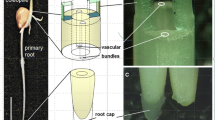Abstract
The observation that a starchless mutant (TC7) of Arabidopsis thaliana (L.) Heynh. is gravitropic (T. Caspar and B.G. Pickard, 1989, Planta 177, 185–197) raises questions about the hypothesis that starch and amyloplasts play a role in gravity perception. We compared the kinetics of gravitropism in this starchless mutant and the wild-type (WT). Wild-type roots are more responsive to gravity than TC7 roots as judged by several parameters: (1) Vertically grown TC7 roots were not as oriented with respect to the gravity vector as WT roots. (2) In the time course of curvature after gravistimulation, curvature in TC7 roots was delayed and reduced compared to WT roots. (3) TC7 roots curved less than WT roots following a single, short (induction) period of gravistimulation, and WT, but not TC7, roots curved in response to a 1-min period of horizontal exposure. (4) Wild-type roots curved much more than TC7 roots in response to intermittent stimulation (repeated short periods of horizontal exposure); WT roots curved in response to 10 s of stimulation or less, but TC7 roots required 2 min of stimulation to produce a curvature. The growth rates were equal for both genotypes. We conclude that WT roots are more sensitive to gravity than TC7 roots. Starch is not required for gravity perception in TC7 roots, but is necessary for full sensitivity; thus it is likely that amyloplasts function as statoliths in WT Arabidopsis roots. Furthermore, since centrifugation studies using low gravitational forces indicated that starchless plastids are relatively dense and are the most movable component in TC7 columella cells, the starchless plastids may also function as statoliths.
Similar content being viewed by others
Abbreviations
- S2:
-
story two
- S3:
-
story three
- WT:
-
wild-type
References
Audus, L.J. (1979) Plant geosensors. J.Exp. Bot. 30, 1051–1073
Behrens, H.M., Gradmann, D., Sievers, A. (1985) Membranepotential responses following gravistimulation in roots of Lepidium sativum L. Planta 163, 463–472
Caspar, T., Huber, S.C., Somerville, C. (1985) Alterations in growth, photosynthesis, and respiration in a starchless mutant of Arabidopsis thaliana (L.) deficient in chloroplast phosphoglucomutase activity. Plant Physiol. 79, 11–17
Caspar, T., Pickard, B.G. (1989) Gravitropism by a starchless mutant of Arabidopsis: implications for the starch-statolith theory of gravity sensing. Planta 177, 185–197
Filner, B., Hertel, R., Steele, C., Fan, V. (1970) Some aspects of geotropism in coleoptiles. Planta 94, 333–354
Haughn, G.W., Somerville, C. (1986) Sulfonylurea-resistant mutants of Arabidopsis thaliana. Mol. Gen. Genet. 204, 430–434
Hawker, L.E. (1932) A quantitative study of the geotropism of seedlings with special reference to the nature and development of their statolith apparatus. Ann. Bot. 46, 121–157
Hensel, W. (1984) A role of microtubules in the polarity of statocytes from roots of Lepidium sativum L. Planta 162, 404–414
Hertel, R., de la Fuente, R.K., Leopold, A.C. (1969) Geotropism and the lateral transport of auxin in the corn mutant amylomaize. Planta 88, 204–214
Hillman, S.K., Wilkins, M.B. (1982) Gravity perception in decapped roots of Zea mays. Planta 155, 267–271
Johnsson, A., Pickard, B.G. (1979) The threshold stimulus for geotropism. Plant Physiol. 45, 315–319
Larsen, P. (1962) Orthogeotropism in roots. In: Encyclopedia of Plant Physiology, vol. 17; Movements in plants, pt. 2, pp. 153–199, Ruhland, W., ed. Springer, Berlin Göttingen Heidelberg
Lin, T.-P., Caspar, T., Somerville, C., Preiss, J. (1988) Isolation and characterization of a starchless mutant of Arabidopsis thaliana (L.) Heynh. lacking ADPglucose phosphorylase activity. Plant Physiol. 86, 1131–1135
Moore, R. (1987) Root gravitropism in a cultivar of Zea mays whose columella cells contain starch-deficient amyloplasts. Ann. Bot. 59, 661–666
Moore, R., Evans, M.L. (1986) How roots perceive and respond to gravity. Am. J. Bot. 73, 574–587
Moore, R., McClelen, C.E. (1985) Root graviresponsiveness and columella cell structure in carotenoid-deficient seedlings of Zea mays. Ann. Bot. 56, 83–90
Pickard, B.G. (1973) Geotropic response patterns of the Avena coleoptile. I. Dependence on angle and duration of stimulation. Can. J. Bot. 51, 1003–1021
Pickard, B.G., Thimann, K.V. (1966) Geotropic response of wheat coleoptiles in absence of amyloplast starch. J. Gen. Physiol. 49, 1065–1086
Roberts, J.A. (1984) Tropic responses of hypocotyls from normal tomato plants and the gravitropic mutant Lazy-1. Plant Cell Environ. 7, 515–520
Sack, F.D. (1987) The structure of the stem endodermis in etiolated pea seedlings. Can. J. Bot. 65, 1514–1519
Sack, F.D., Kiss, J.Z. (1989) Rootcap structure in wild-type and in a starchless mutant of Arabidopsis. Am. J. Bot. 76, in press
Sack, F.D., Suyemoto, M.M., Leopold, A.C. (1984) Kinetics of amyloplast sedimentation in gravistimulated maize coleoptiles. Planta 161, 459–464
Sack, F.D., Suyemoto, M.M., Leopold, A.C. (1986) Amyloplast sedimentation and organelle saltation in living corn columella cells. Am. J. Bot. 73, 1692–1698
S.A.S. (1982) Statistical Analysis System user's guide: statistics. S.A.S. Institute, Cary, North Carolina
Song, I., Lu, C.R., Brock, T.G. Kaufman, P.B. (1988) Do starch statoliths act as gravisensors in cereal grass pulvini? Plant Physiol. 86, 1155–1162
Volkmann, D., Sievers, A. (1979) Graviperception in multicellular organs. In: Encyclopedia of Plant Physiology, N.S., vol. 7: Physiology of movements, pp. 573–600, Haupt, W., Feinleib, M.E., eds. Springer, Berlin Heidelberg New York
Wendt, W., Sievers, A. (1986) Restitution of polarity in statocytes from centrifuged roots. Plant Cell Environ. 9, 17–23
White, R.G., Sack, F.D. (1986) Actin microfilaments in the presumptive statocytes of grass coleoptiles. (Abstr.) J. Cell Biol. 103, 110a
Author information
Authors and Affiliations
Rights and permissions
About this article
Cite this article
Kiss, J.Z., Hertel, R. & Sack, F.D. Amyloplasts are necessary for full gravitropic sensitivity in roots of Arabidopsis thaliana . Planta 177, 198–206 (1989). https://doi.org/10.1007/BF00392808
Received:
Accepted:
Issue Date:
DOI: https://doi.org/10.1007/BF00392808




